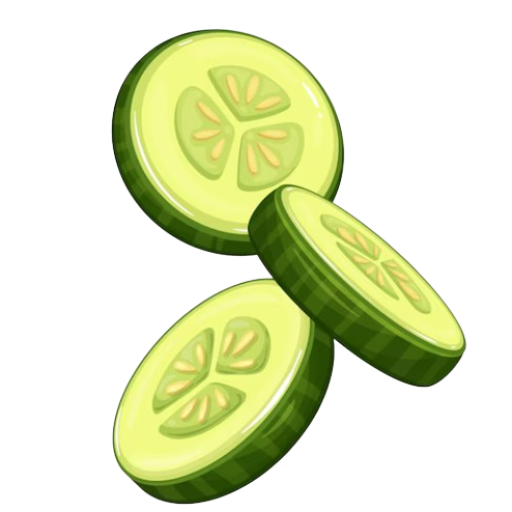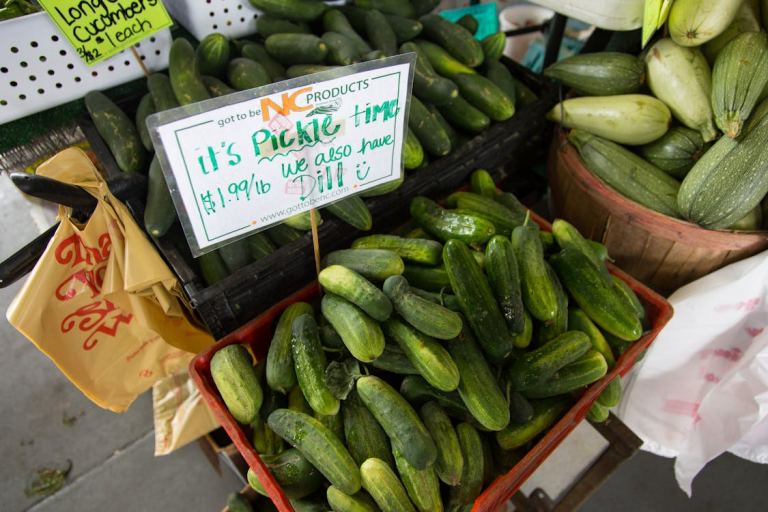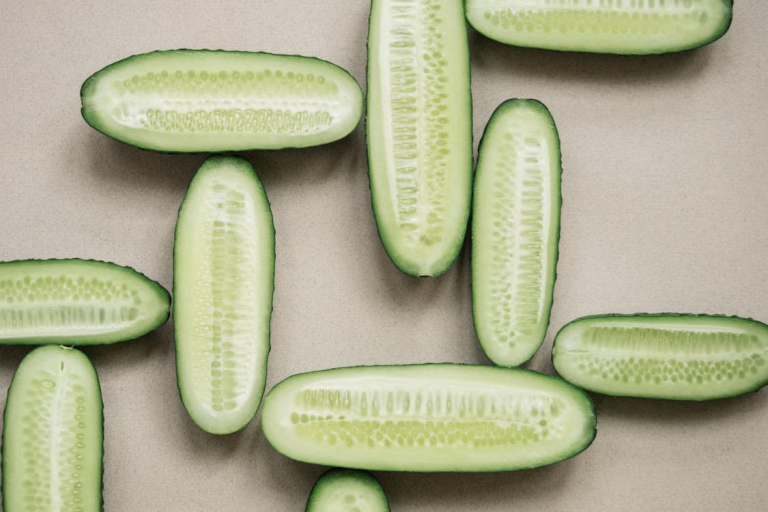Benefits of Cucumbers for Wellness

A nutrient-dense food with a high water content is cucumbers. They are a great source of essential vitamins and minerals and can aid in the relief of dehydration. Cucumbers may also be good for the skin.
The cucumber is a member of the Cucurbitaceae family. Other members of the family include squash and different kinds of melon, including bitter melon. Cucumbers provide various nutrients but are low in calories, fat, cholesterol, and sodium.
People in India have grown cucumbersTrusted Source for food and medicinal purposes since ancient times, and they have long been part of the Mediterranean diet.
This article looks at the nutritional content of cucumber, its possible health benefits, tips for eating or using cucumber, and any potential health risks.
Benefits
The nutritional profileTrusted Source of cucumbers may give them a number of health benefits.
1) Hydration

Cucumbers consist mostly of water, and they also contain important electrolytes. They can help prevent dehydration in hot weather or after a workout.
For people who do not enjoy drinking water, adding cucumber and mint can make it more attractive.
Staying hydrated is essential for maintaining a healthy intestine, preventing constipation, avoiding kidney stones, and more.
Cucumber is one of the most hydrating foods. What other foods are good for hydration?
2) Bone health
Vitamin K helps withTrusted Source blood clotting, and it may support bone health.
A 142-gram (g) cupTrusted Source of chopped, unpeeled, raw cucumber provides 10.2 micrograms (mcg) of vitamin K, according to the United States Department of Agriculture (USDA).
The 2015–2020 Dietary Guidelines for Americans recommend an intakeTrusted Source of:
- 90 mcg a day for females aged 19 years and over
- 120 mcg for males of the same age
Cucumber also contains 19.9 milligramsTrusted Source (mg) of calcium. Adults needTrusted Source 1,000–1,200 mg of calcium a day, depending on sex and age.
Vitamin K helps improve calcium absorption. Together, these nutrients can contribute to good bone health.
Vitamin D is also important for bone health. Find out more.
3) Cancer
As a member of the Cucurbitaceae family of plants, cucumbers contain high levels of bitter-tasting nutrients known as cucurbitacin.
According to an articleTrusted Source in the International Journal of Health Services, cucurbitacins may help prevent cancer by stopping cancer cells from reproducing.
A 133-g cupTrusted Source of chopped cucumber with its skin also provides around 1 g of fiber. Fiber may help protect against colorectal cancer.
How can the foods we eat affect the risk of cancer? Find out here.
4) Cardiovascular health
The American Heart AssociationTrusted Source (AHA) note that fiber can help manage cholesterol and prevent related cardiovascular problems.
A 142-g cup of unpeeled cucumber also provides 193 mg of potassium and 17 mg of magnesium. The Dietary Guidelines recommend that adults consume 4,700 mg of potassium each day and 310–410 mg of magnesium, depending on sex and age.
Reducing sodium intake and increasing potassium intake may help preventTrusted Source high blood pressure.
The cucurbitacins in cucumber may also help preventTrusted Source atherosclerosis.
5) Diabetes
Cucumbers may play a roleTrusted Source in controlling and preventing diabetes. It contains substances that may help lower blood sugar or stop blood glucose from rising too high.
One theory is that the cucurbitacins in cucumber help regulate insulin release and the metabolism of hepatic glycogen, a key hormone in the processing of blood sugar.
One studyTrusted Source found that cucumber peel helped manage the symptoms of diabetes in mice. This may be due to its antioxidant content.
Fiber, too, may help preventTrusted Source and manage type 2 diabetes, according to the AHA.
Cucumbers score low score on the glycemic index (GI). This means they provide essential nutrients without adding carbohydrates that can increase blood glucose.
What kind of diet can help manage diabetes? Learn more here.
6. Inflammation
Cucumbers may have anti-inflammatory benefitsTrusted Source. Inflammation is a function of the immune system.
Experts believe inflammation may help trigger the development of various health conditions, such asTrusted Source:
- cardiovascular disease
- diabetes
- autoimmune conditions
- depression
- cancer
7. Skin care
Some research has suggested that cucumber’s nutrients may provide benefits for skin health.
Applying sliced cucumber directly to the skin can help cool and soothe the skin and reduce swelling and irritation. It can alleviate sunburn. Placed on the eyes, they can help decrease morning puffiness.
Other cucumber beauty tips include:
Toner: Blend and sieve cucumber to collect the juice for a natural toner. Leave on the skin for 30 minutes, then rinse. Cucumber may have astringent properties, and it may help clear the pores.
Face pack: Mix equal amounts of cucumber juice and yogurt to make a face pack that helps reduce dry skin and blackheads.
Cucumber is safe for most people to use on the skin. People should start by applying a small amount. If they do not experience an adverse reaction, it is probably safe to use.
Learn more here about skin-friendly foods.
Nutrition
According to the USDA, one 142-g cupTrusted Source of unpared, raw, chopped cucumber contains the following nutrients:
- water: 137 g
- calories: 17
- protein: 0.8 g
- fat: 0.2 g
- carbohydrate: 3.1 g, including 2.0 g of sugar
- fiber: 1.0 g
- calcium: 19.9 g
- iron: 0.3 mg
- magnesium: 17 mg
- phosphorus: 29.8 mg
- potassium: 193 mg
- sodium: 2.8 mg
- vitamin C: 4.5 mg
- folate: 19.9 mcg
- beta carotene: 44 mcg
- lutein + zeaxanthin 22.7 mcg
- vitamin K: 10.2 mcg
Cucumber also contains a range of B vitamins, vitamin A, and antioxidants, including a type known as lignans.
Antioxidants help remove substances from the body known as free radicals. Some free radicals come from natural bodily processes, and some come from outside pressures, such as pollution. If too many collect in the body, they can lead to cell damage and various types of disease.
StudiesTrusted Source have suggested that the lignans in cucumber and other foods may help lower the risk of cardiovascular disease and several types of cancer.
Types
The most commonly available type of cucumber is the hothouse or English cucumber. It is large, with dark green skin, and few or no seeds.
According to one source, other types of cucumber include:
Armenian, or snake cucumbers: These are long and twisted with thin, dark green skin and pale furrows. People often use them for pickling.
Japanese cucumbers: These are dark green and narrow. The skin is thin with small bumps on it. People can eat them whole.
Kirby cucumbers: People often use these for dill pickles. They are crispy, with thin skin and small seeds.
Lemon cucumber: These are around the size of a lemon, with pale skin. The taste is sweet and delicate.
Persian cucumbers: Shorter and fatter than the hothouse cucumber, these are crunchy to eat.
The wild cucumber vine (Echinocystis lobata) is a fast-growing plant that is native to North America. Gardeners consider it a weed. Its fruits are not edible.
Tips
Choose crisp, firm cucumbers and avoid those with shriveled or withered ends. Store in the refrigerator for up to a week.
Some producers apply a wax coating to cucumbers after picking them. Do not wash these before storing, but rinse thoroughly or peel before consuming.
People usually consume cucumbers raw. Their mild taste and refreshing crunch make them suitable for:
- adding to salads or sandwiches
- accompanying rich or highly flavored dishes, such as curries and stews
They pair well with a range of foods, including cheese, turkey, salmon, and nut butter.
Try the following:
- Mix sliced cucumbers, tomatoes, olives, and feta cheese for a Greek-style side dish.
- Jazz up water by adding mint leaves and cucumber.
- Slice cucumbers into thick slices and dip them in your favorite hummus.
- Blend cucumbers alone or other vegetables, such as carrots and celery, to make a juice.
- Make gazpacho soup by blending with tomatoes, pimentos, garlic, onions, and bread crumbs and then chilling.
- Mix with garlic, mint, and Greek yogurt to accompany a curry.



